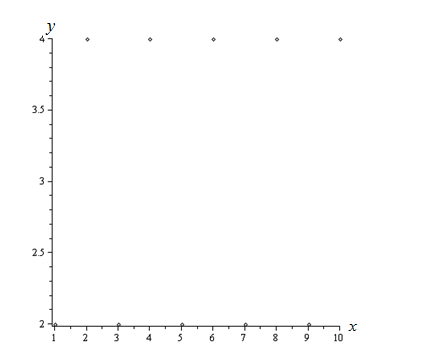
Concept explainers
a.
Graph the first
a.
Answer to Problem 2PS

Explanation of Solution
Calculation:
Let us find the first
The sequence is
The first
Using the values derived above, we plot theses in the graph below

b.
Describe the behaviour of the graph of the sequence.
b.
Answer to Problem 2PS
Explanation of Solution
Calculation:
Hence, the graph in (a) shows that when
c.
Complete the table.
c.
Answer to Problem 2PS
Explanation of Solution
Calculation:
We put in different values of
Using the above, we can fill the table as below
Hence, we see that
d.
Determine (if possible) the value of
d.
Answer to Problem 2PS
It is not possible to find the value of
Explanation of Solution
Calculation:
We have seen in (b) that when
This pattern continues as
Hence, it is not possible to find the value of
Chapter 9 Solutions
EBK PRECALCULUS W/LIMITS
- Pls help me with the accurate answer and solution asap plsarrow_forwardPls help me with accurate answer and solution asap plsarrow_forwardV. Consider the power series Σ (-2x-1)" (5)²+n n=1 1. Show that the series obtained when x = 2 is conditionally convergent. (6 points) 2. If the radius of convergence is ½, find the interval of convergence of the power series. (2 points)arrow_forward
- Assuming tumor mass is proportional to its volume, the diameter of the tumor is related to its mass as D = aM1/3 where a > 0. Derive a differential equation for D and show that it can be written as the von Bertalanffy equation. (The von Bertalanffy equation is dL da = k(L∞ − L), where L(a) is length (in cm) at age a (in years), L∞ is the asymptotic length, and k is a positive constant whose units are 1/year.)We know that D = aM^1/3 --> dD/dt = ? The von Bertalanffy equation can be written as dD/dt = A(B-D), then A = ? and B = ?arrow_forward1. The average value of f(x) = ✓ on [1,4] and instantaneous rate of change at x = 16 2. f(x) = x³-3x² + 4 Find all relative extrema, inflection point, and the intervals of concavityarrow_forward2. f(x) = x³-3x² +4 Find all relative extrema, inflection point, and the intervals of concavity 5 3. f(x) = 3x3 - 15x3 Find the intervals of increasing, decreasingarrow_forward
- 5 2 3. f(x) = 3x3 - 15x3 Find the intervals of increasing, decreasing 4. If xy+cos y, Findarrow_forwardI. Perform the following integrations. 1. L' (2x + 1)e³r da cot³ (ln x) csc³ (ln x) 2. dx х 3. 4. x² √1-92 dx 3x3 +14x+7 x² (x²+7) dxarrow_forwardIV. Consider the equation : y + z = 2. 1. Sketch a portion of the graph of π in the first octant in R3. Indicate proper rulings. [2 pts.] 2. Find an equation of the surface generated by revolving the trace of π on the the yz-plane about the y-axis. Sketch the surface of revolution. [3 pts.]arrow_forward
- IV. Consider the function f(x) = esin 2x 1. Find the second-degree Maclaurin polynomial of f(x). 2. Approximate esin 0.02 using the result in IV.1. Express your answer in decimal form.arrow_forward2+5n2 1. Determine whether the sequence (b) converges or diverges. 2. Determine whether the following series converge or diverge. State the test you us 3n² - n I. Let bn = for n N with n ≥ 1. نے n=1 8 b. (bn)" n=1arrow_forwardII. Determine whether the following series converge or diverge. State the test you used. (4/2/3 po 1 1. n(Inn)2 n=3 2. 8 IM n=1 5" + sin² n 3n 00 1.3 " 3. (2n − 1) (n + 2)! - n=1arrow_forward
 Calculus: Early TranscendentalsCalculusISBN:9781285741550Author:James StewartPublisher:Cengage Learning
Calculus: Early TranscendentalsCalculusISBN:9781285741550Author:James StewartPublisher:Cengage Learning Thomas' Calculus (14th Edition)CalculusISBN:9780134438986Author:Joel R. Hass, Christopher E. Heil, Maurice D. WeirPublisher:PEARSON
Thomas' Calculus (14th Edition)CalculusISBN:9780134438986Author:Joel R. Hass, Christopher E. Heil, Maurice D. WeirPublisher:PEARSON Calculus: Early Transcendentals (3rd Edition)CalculusISBN:9780134763644Author:William L. Briggs, Lyle Cochran, Bernard Gillett, Eric SchulzPublisher:PEARSON
Calculus: Early Transcendentals (3rd Edition)CalculusISBN:9780134763644Author:William L. Briggs, Lyle Cochran, Bernard Gillett, Eric SchulzPublisher:PEARSON Calculus: Early TranscendentalsCalculusISBN:9781319050740Author:Jon Rogawski, Colin Adams, Robert FranzosaPublisher:W. H. Freeman
Calculus: Early TranscendentalsCalculusISBN:9781319050740Author:Jon Rogawski, Colin Adams, Robert FranzosaPublisher:W. H. Freeman
 Calculus: Early Transcendental FunctionsCalculusISBN:9781337552516Author:Ron Larson, Bruce H. EdwardsPublisher:Cengage Learning
Calculus: Early Transcendental FunctionsCalculusISBN:9781337552516Author:Ron Larson, Bruce H. EdwardsPublisher:Cengage Learning





